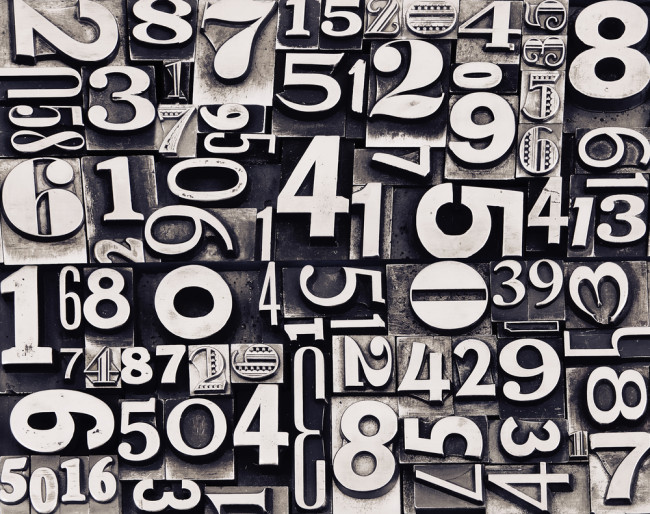THE REAL GIG: Numbers aren’t always fun, but they can be essential to creativity

Last week, I was talking about personal philosophies and dreams. This week, I want to flip that coin. Today, we talk about numbers.
Numbers are not all that fun to hang out with. In fact, they can be pretty damn boring and a royal pain in the ass. If you are going out for a night on the town, it’s no fun to take numbers with you. They are always reminding you that what you are doing doesn’t make any sense. They are always pointing out much more profitable ways you should be spending your time and money.
I tell my numbers to piss off all the time.
Numbers love tax season. They sincerely enjoy balancing a checking account. When the unexpected happens, numbers are the first to look at you and say, “I told you so.” Numbers are assholes… largely because they are never wrong.
Your heart can’t speak number language. It doesn’t even like to try. Number people roll their eyes at heart people. The problem is, they both need each other. Heart people make stupid decisions – a lot – but, every once in a while, they deliver brilliance. Number people are incredibly consistent, but they are often bland as hell.
But the good thing about numbers, as the saying goes, is that they don’t lie. They keep you on task when you are frustrated and feel like quitting. They dangle a carrot just out of reach and they don’t give a damn how much you ask for a bite. They push you to new heights.
Hearts make great artists and philosophers. Numbers are better sergeants.
So where am I going with this? As an independent musician (or any other artist), you need to be both a heart and number person. There are many, many other occupations where this is not the case. In many occupations, if you show up on time and do your job consistently, you will be fine. Not so for the musician. You need to be both. If you are all heart, your emotions will blow you all over the place. If you are all numbers, your work will bore the bejesus out of everyone you play for.
If you read about any author’s process, there will be a number element to it. Ernest Hemingway wrote 500 words a day, in the morning… standing up. Prince and Stevie Wonder wrote a song a day. Beethoven would get up, count out exactly 60 coffee beans for his morning coffee, and compose for nine hours.
They weren’t always brilliant, but they were always there. As the author Tom Robbins put it, “My muse doesn’t visit me every day, but she knows where to find me.”
Here are a few ideas for you:
Whenever you find your gig schedule getting lighter than you want, try getting in the habit of calling, e-mailing, or texting 20 people a day. It doesn’t matter if a few of the 20 people are your grandmother and sister. It doesn’t matter if you are just texting someone you haven’t talked to in a while to say hello. After a few days, opportunities are going to start to come from it. It happens every time. The number 20 will push you forward and make you get creative as you run out of people to contact.
I reference the book “Outliers” often. The author Malcolm Gladwell believes that it takes 10,000 hours to master something. That’s about 20 hours a week for 10 years, or about 40 hours a week for five years. When you look at the careers of athletes, musicians, or whoever, this number makes sense. 10,000 hours to become a samurai. You just break it down into months, weeks, and days and let the numbers keep you disciplined.
In the book “The Medici Effect,” author Franz Johansson talks about think tanks. He was speaking about using the technique of coming up with 20 solutions to a problem. Don’t worry how plausible they are – just come up with 20 ideas. The first five or six will be pretty conventional. Then, as you run out of ideas, you get creative, and that is where the gold is.
He spoke of one particular think tank where they were trying to find a way to keep ice off of power lines in a remote region. The first several solutions were conventional – find a way to heat the lines, insulate the lines, etc. Then things got weird. One of the later ideas was to put honey pots on top of the telephone poles so bears would shake the poles and dislodge the ice. This led them to the idea of using vibrations. They hadn’t thought of that, and that led them to the idea of using helicopters to fly over the wires and vibrate the ice off, which was ultimately the solution they wanted.
Take a problem and find 20 solutions, no matter how insane. Solution 16 is going to be something you never thought of before, guaranteed.
Another one I like to use is number sequences in songwriting. For example, say your birthday is June 7, 1994. Write a part that has a measure of six, a measure of seven, and one, nine, nine, four. You will wow your friends with the incredibly complex piece you just wrote but, in reality, you are just playing your birthday. This works while soloing as well.
The band Rush allegedly based the opening sequence of their classic “YYZ” on Morse code for the radio call letters of Toronto’s Pearson International Airport.
Finally, take a song you like and write down the number of lines and rhythm of it. Then, write a new song with those parameters. Songwriters tend to go to their happy place when they write and do a lot of the same things. They write songs with the same number of lines in the verses and chorus with the rhyme schemes in the same places. If you strip another tune down to the studs and use those dimensions (say a six-line verse with rhymes on line three and six and a five-line chorus with the rhymes on line two and four), you will be forced to write out of your comfort zone.
Ain’t nobody gonna know.
Bob Dylan wrote “Subterranean Homesick Blues” based on Chuck Berry’s “Too Much Monkey Business.” No one would ever guess they were related unless it was pointed out to you.
Well, anyway, all this number talk is making me tired. I’m going back to letting my mind wander like it usually likes to do.
As artists, we like to read about those lightning bolt moments that inspired all of our favorite stuff. But, in reality, those moments can be few and far between.
Hopefully, I have given you a few examples of how the simple act of counting on your fingers and toes can help you get a little more water out of the well too.
It’s as easy as 1-2-3…
Bret is a songwriter, engineer, producer, and multi-instrumentalist based in NEPA. He splits his time between producing at his studio, Saturation Acres, and performing solo and with his band, Gentleman East. He is also one of the founding members of The Badlees.

